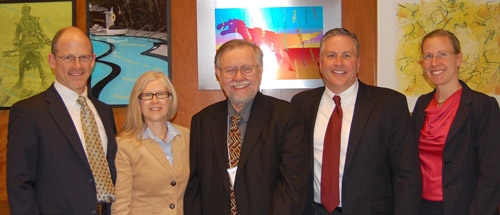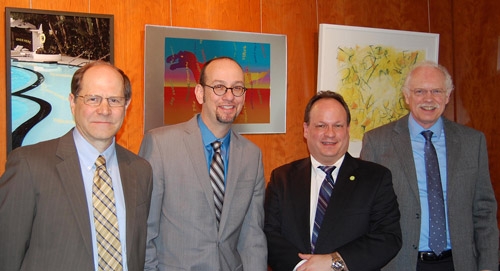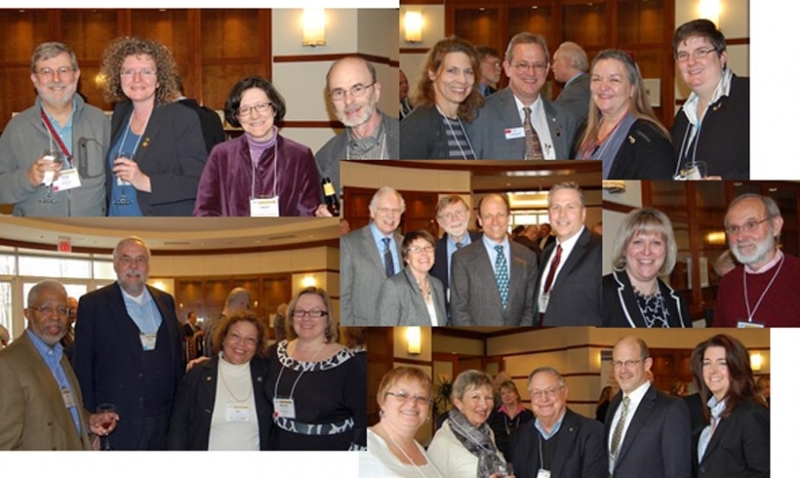AIP was pleased to welcome a large delegation of Member and Affiliated Society representatives to the annual Assembly of Society Officers last Thursday, March 27. More than 100 attendees came together to learn about issues that professional societies strive to address, to share information, and connect with the community of Member and Affiliated societies in the AIP family.

Cultivating society membership in the private sector is one area that requires specific attention and investment, but one that promises to grow our impact if we are successful in our efforts. Bob Doering of Texas Instruments remarked about how the required skill set for scientists in industry differs from those in academia. Private sector scientists need to work well with interdisciplinary teams; they are not necessarily distinguished by their specific field; and they need to keep a lot of their work from the outside world, thus avoiding “teaching too much” to competitors. Publications are much less important than timely project results. His message to societies stressed engagement with physicists in industry on a personal level—invite them to participate in advisory boards, seminars, and visits to local campuses. Societies should promote opportunities for industrial post-docs and sabbaticals at industrial labs, and to connect academic and industrial research via consortia.
Melissa Russell of OSA, David Harwell of ACS, Crystal Bailey of APS, and Todd Osman of MRS spoke about their associations’ efforts to reach potential members, particularly those in the early stages of their careers. OSA tries to bridge the gap between applied science and commercial applications, reaching out to companies, but also to the customers of those companies. Integrated with the products’ marketing message is the promotion of—and to a certain extent, education about—the optical sciences. Industry is looking for access to timely research, market and funding information, and an opportunity to network and find new customers, partners, collaborators and distributors. They want to participate in programs that have an impact on the community, recruit qualified R&D staff, and showcase new technologies and products. OSA builds their program offerings around satisfying these needs.
ACS recognizes that their members—50 percent of whom work in industry—have many different roles, and their program is multi-faceted. One rather unique offering is the ACS Entrepreneurial Resources Center, focused on satisfying the needs of small companies and those employed in these ventures. For this demographic ACS provides information resources, mentoring, “tiger team” evaluations, showcase events, and entrepreneurial summits. They also help members with career development through professional education, webinars, leadership training, and market intelligence.
Likewise, APS has placed a special emphasis on early career scientists, especially over the past few years. They support student-organized regional professional development events, and have organized a series of webinars to connect with students and help them find their way as professional scientists. MRS takes an alternative approach to serving members in industry. Feedback from their focus groups indicated that their industry stakeholders would rather MRS focus on supporting good quality education, saving the training and professional development for the companies themselves. Subsequently, MRS serves this segment through advocacy and with opportunities for STEM outreach.

The assembly then turned the focus to retaining middle school students’ interest in science. Panelists discussed creative and innovative programs that tap the interest of young people before they self-select out of science. Larry Bell of the Museum of Science in Boston reported that students begin to see science as less inspiring and relevant to their lives with the middle school science curriculum. But there is also a correlation between self-confidence and academic performance; low self-efficacy characterized by the middle school years influences students’ choices to study more “difficult” subjects like math and science. Bell asserts that scientific societies are well positioned to reach the community with informal science education, and help students of all ages maintain an interest in science. He gave an excellent example of one such high-impact program, the Nanoscale Informal Science Education Network (NISE Net). This collaboration of 500 organizations produces a wide range of educational materials for students while offering professional development for educators and scientists.
Rick Tankersley of the NSF described an innovative program that combines science communication and informal science education, the Ocean 180 video challenge. He started by giving some sobering statistics: 90 percent of published works do not get cited, and only about half get read. Broadening the impact of published works is a challenge that all researchers face. Given that 55 percent of internet users view some video daily, the Ocean 180 project challenged scientists to communicate their published research, creatively, in just three minutes. Entrants faced the toughest of judges: 31,000 middle school students from across the country. Why middle school? Aside from the reasons listed above, science for public consumption assumes the general public has about an 8th grade level of science literacy. You might be surprised with their choice for the winning video: Wavechasers and the Samoan Passage, which explains the dynamics of internal waves.
Becky Thompson of APS talked about how PhysicsQuest is effectively reaching middle schoolers, especially girls, through comics and hands-on kits. Their dive into “Edutainment” has resonated with the demographic, by engaging their imagination and integrating their social concerns. The education is done on the sly. Students enjoy reading about the heroine, Spectra, and the cast of characters as they battle and discover, and simultaneously do activities about topics in modern physics. More than 350,000 students use PhysicsQuest each year; cumulatively, the program has reached more than three million since 2005.
Phil Sadler of the Harvard Smithsonian Center for Astrophysics talked about a program that deepens student interest in astronomy, by providing students with access to telescopes through the MicroObservatory Network. Middle school students and their teachers are able to view the skies through five automated telescopes via the World Wide Web, remotely point and focus the telescopes, and take their own images. The partnership of organizations, scientists and graduate students prepares sample challenges and curriculum materials. The program also includes travelling exhibits for museums and professional development.

Readers of this column should be somewhat familiar with the final topic of discussion: Public access and Implications for scholarly publishing. This had been a recurring theme in recent past Assemblies, and will likely remain a concern in the coming years. David Crotty of Oxford University Press framed the public access issue, and how different government bodies and institutions from around the world are addressing public access and the varying embargos that are typically 6 – 12 months. Crotty noted that the researchers themselves are less concerned with public access than funding agencies and policy makers. Rather, researchers’ priorities center more on journal impact factor and time to publication. They want to be recognized for their work, favor restrictive licenses that protect their intellectual property, and generally have access to the body of research that they need.
Howard Ratner of CHOR, Inc., informed the scholarly publishers in attendance about CHORUS (Clearinghouse for the Open Research of the United States), of the publishing community’s response to public access, to satisfy the requirements set forth by the White House last February. Stakeholders, characterized by Alan the Agency Head, Lottie the Librarian, Peter the Public, Rachel the Researcher and Penny the Publisher, all have different wants and expectations in terms of public access—and CHORUS aims to satisfy all of the stakeholders in an automated system built on existing infrastructure.
What to do about data? Making the data behind the research accessible to the public remains a challenge. Dave Martinsen of ACS provided some insight on the issue. Unlike publications, an integrated infrastructure does not exist for data. Moreover, questions need to be resolved, such as, what quantity of data is wanted or needed? An incredible amount of data from research exists on “disks in drawers.” How much of this is practical to make public? Several communities are looking into this issue. For example, AAS and AIP are working with the NSF to gather community requirements and to standardize metadata, and to link published articles to associated datasets. There are several repositories cropping up to handle the data, but it is yet to be seen how the overall solution will play out. Martinsen notes that there is a growing demand for skilled data curators. Societies have an active role to play in this area. Only by engaging with the community to devise workable solutions can we influence policy that will affect our publishing industry.
This brief summary merely skims the surface of the information shared during the assembly, but I hope that I have sufficiently piqued your interest to compel you to peruse the speakers’ presentations and learn more. Thanks to our speakers and to all those who attended. We hope that our Member and Affiliated Society leadership will join us for our next assembly on March 26, 2015.

